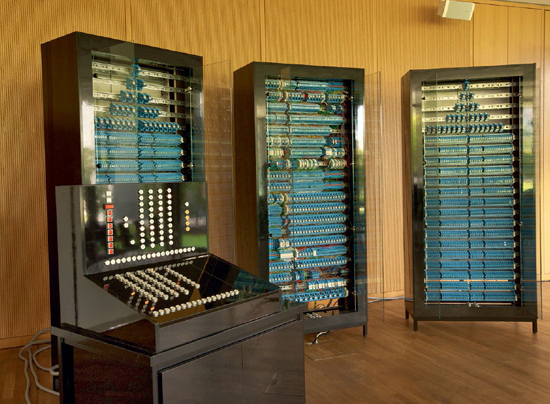1941
Z3 Computer
Konrad Zuse (1910–1995)
The Z3 was the world’s first working programmable, fully automatic digital computer. The machine executed a program on punched celluloid tape and could perform addition, subtraction, multiplication, division, and square roots on 22-bit binary floating-point numbers (because binary math was more efficient than decimal); it had 64 words of 22-bit memory for storing reswults. The machine could convert decimal floating points to binary for input, and binary floating points back to decimal for output.
Graduating with a degree in civil engineering in 1935, German inventor Konrad Zuse immediately started building his first computer, the Z1 (constructed 1935–1938), in his parents’ apartment in Berlin. The Z1 was a mechanical calculator controlled by holes punched in celluloid film. The machine used 22-bit binary floating-point numbers and supported Boolean logic; it was destroyed in December 1943 during an Allied air raid.
Drafted into military service in 1939, Zuse started work on the Z2 (1939), which improved on the Z1’s design by using telephone relays for the arithmetic and control logic. DVL, the German Research Institute for Aviation, was impressed by the Z2 and gave Zuse funds to start his company, Zuse Apparatebau (Zuse Apparatus Construction, later renamed Zuse KG), to build the machines.
In 1941, Zuse designed and built the Z3. Like the Z1 and Z2, it was controlled by punched celluloid tape, but it also had support for loops, allowing it to be used for solving many typical engineering calculations.
With the success of the Z3, Zuse started working on the Z4, a more powerful machine with 32-bit floating-point math and conditional jumps. The partially completed machine was moved from Berlin to Göttingen in February 1945 to prevent it from falling into Soviet hands, and was completed there just before the end of the war. It remained in operation until 1959.
Surprisingly, it seems that the German military never made use of these sophisticated machines—instead, the machines were largely funded as a research project.
SEE ALSO Atanasoff-Berry Computer (1942), Binary-Coded Decimal (1944)
The control console, calculator, and storage cabinets of the Z3 computer by Konrad Zuse.
